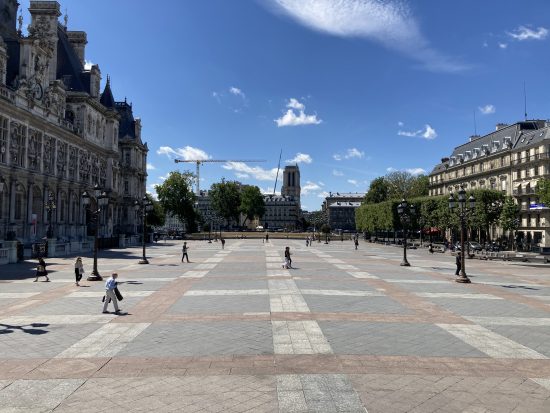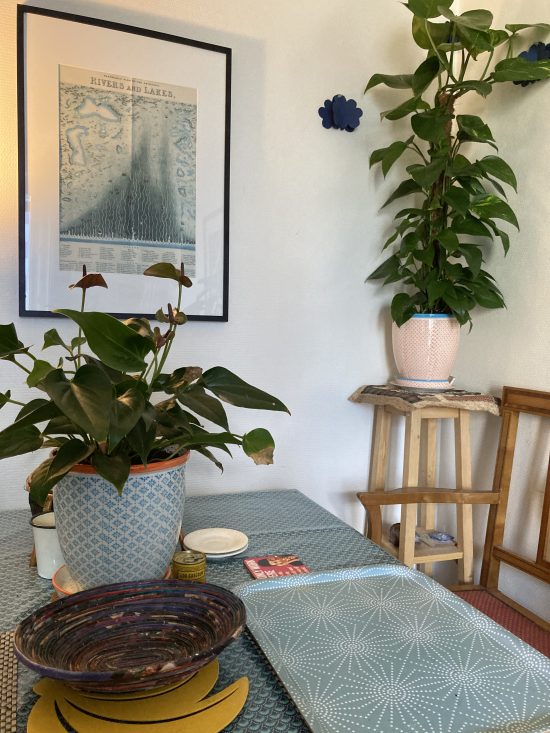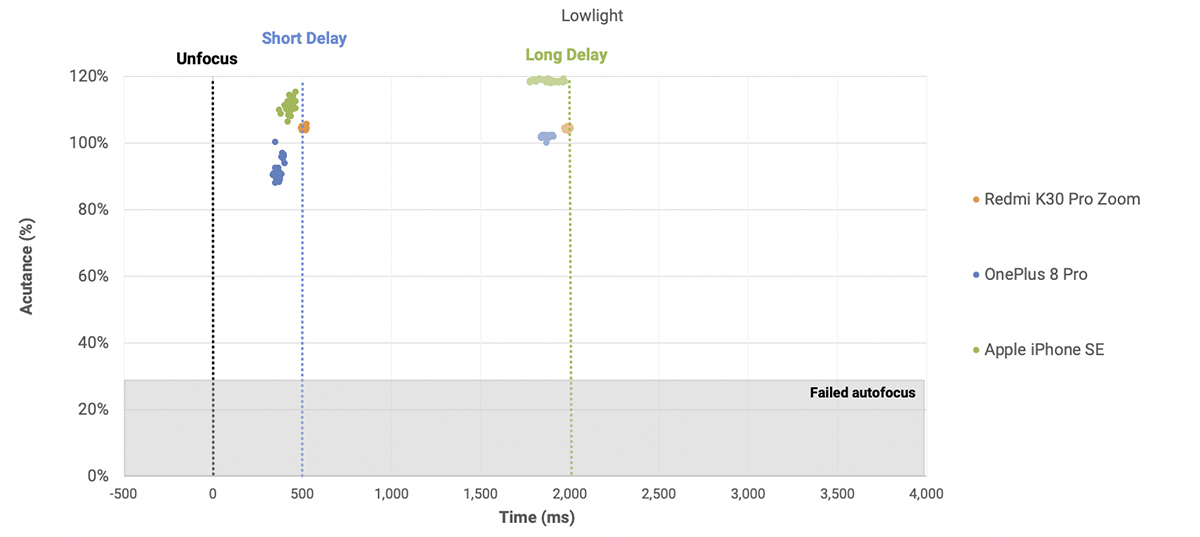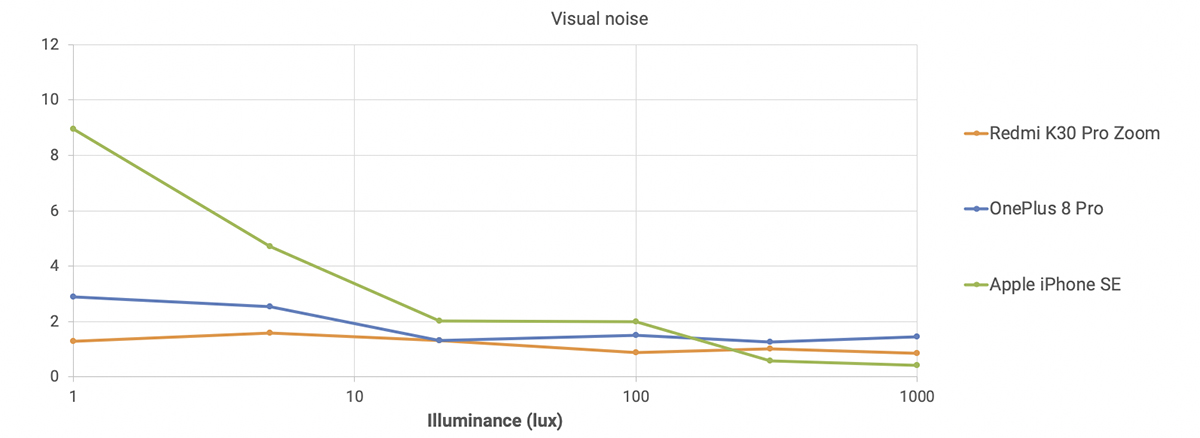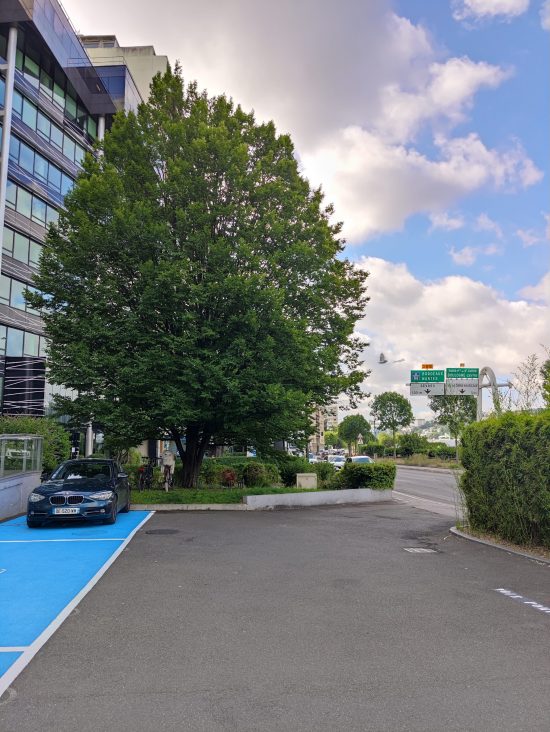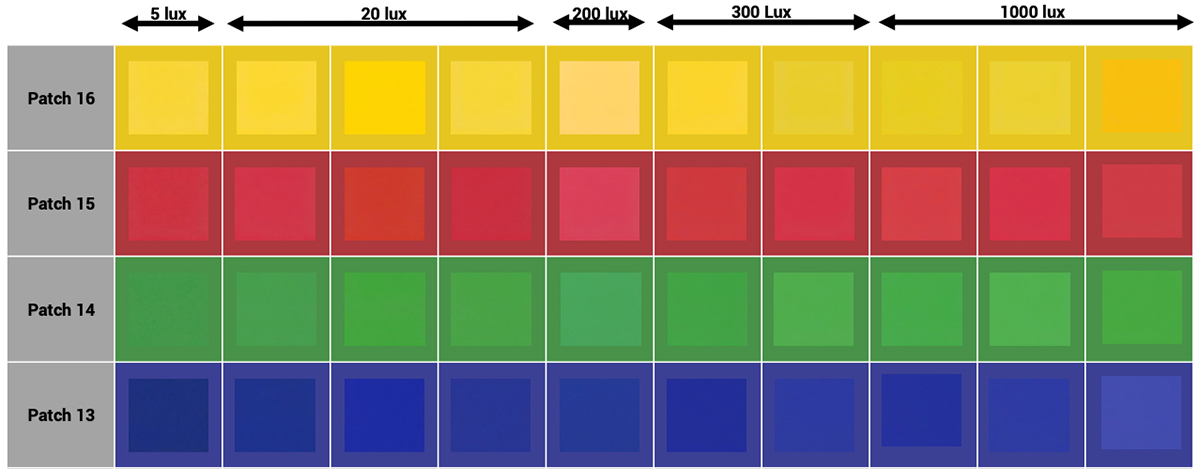The K30 Pro Zoom Edition is the latest flagship in the Chinese manufacturer Xiaomi’s Redmi range of budget-friendly smartphones. Replacing last year’s K20 Pro Premium model, the new device sees upgrades to both the phone spec sheet and camera modules. There’s a slightly larger 6.67-inch FHD+ AMOLED display, a faster Snapdragon 865 chipset, a higher-capacity 4700 mAh non-removable battery, and either 128/256GB storage with 8GB RAM, or 512GB with 12GB RAM.
The K30 Pro Zoom is now a quad camera device, too, thanks to the addition of a new depth sensor alongside the standard wide, ultra-wide, and telephoto cameras. The primary camera offers a higher-resolution 64MP Quad Bayer sensor with a 16MP output (compared to the 48Mp sensor on the K20 Pro Premium), coupled to a 26mm-equivalent standard wide-angle lens with phase-detection autofocus (PDAF) and optical image stabilization (OIS).
The tele-camera continues to utilize a similar 8MP 1/4.0-inch standard array sensor with 1.0µm pixels like its predecessor, but with the addition of a longer 80mm-equivalent lens for 3x optical zoom shots. The K30 Pro Zoom’s dedicated wide-angle camera features a 13MP 1/3.0-inch sensor with 1.12µm pixels and a 16mm-equivalent lens. Finally, for still photos, the addition of a new 2MP depth sensor on the K30 Pro Zoom should help improve bokeh shots.
For video, the K30 Pro Zoom is now 8K enabled, capturing 4320p footage at 24/30fps, as well as 2160p at 30/60fps or Full HD 1080p up to 960fps for super-slow-motion effects. There’s gyroscope-enabled electronic image stabilization (Gyro-EIS) for video, and an innovative adaptive frame rate solution that enables the device to automatically switch between 30 or 60fps depending on the lighting conditions.
Key camera specifications:
- Primary: 64MP 1/1.72-inch Quad Bayer sensor, 26mm-equivalent lens with PDAF and OIS
- Telephoto: 8MP 1/4.0-inch sensor, 80mm-equivalent (x3 optical) lens with PDAF and OIS
- Ultra-wide: 13MP 1/3.0-inch sensor, 16mm-equivalent lens
- Depth: 2MP sensor
- Dual-LED dual-tone flash
- Video: 8K 4320p at 24/30fps, 4K 2160p at 30/60fps, 1080p at 30/60/120/240fps (2160p/30fps tested)
- Video: Gyro-EIS stabilization & adaptive frame rate switching in 4K mode
About DXOMARK Camera tests: For scoring and analysis in our smartphone camera reviews, DXOMARK engineers capture and evaluate over 1600 test images and more than 2 hours of video both in controlled lab environments and in natural indoor and outdoor scenes, using the camera’s default settings. This article is designed to highlight the most important results of our testing. For more information about the DXOMARK Camera test protocol, click here. More details on how we score smartphone cameras are available here.
Test summary


Achieving an overall DXOMARK Camera score of 120, the Xiaomi Redmi K30 Pro Zoom Edition slips into the top 10 in our rankings of smartphone image quality, just behind Xiaomi’s own Mi CC9 Pro at 121. A solid Photo score of 129 means you can be confident of excellent still image quality, with no serious flaws, that often bests competitors in a similar price bracket. Despite lower hardware specifications compared to such high-end Xiaomi devices as the Mi 10 Pro and Mi CC9 Pro, the K30 Pro Zoom manages to produce comparable image quality in many respects.
Global attributes for exposure and color are very well handled. Generally accurate exposure, wide dynamic range, neutral white balance, and good color saturation ensure pleasant results in almost all lighting conditions. The texture/noise compromise is also well controlled. Although it’s fair to say it’s not quite as good as devices with a physically bigger and higher-resolution sensor, for the most part the K30 Pro Zoom’s primary camera delivers well-defined images with low noise. Autofocus is flawless, with quick response times ensuring you capture a picture as soon as requested, and we observed no failures during any of our tests.
It’s not quite all good news, though, with a couple of obvious artifacts letting down what is otherwise a stellar performance from the primary camera. The most obvious problems relate to HDR images, where ghosting on moving objects, together with some unusual texture rendering in some areas, can be a little distracting.
The K30 Pro Zoom’s dedicated ultra-wide camera is a little average overall, but without any serious flaws. The 16mm lens offers a respectable field of view, although serious wide-angle shooters may prefer something a little wider. At its default focal length, exposure isn’t quite as good as the main camera, with slightly low exposures and dynamic range, but it’s acceptable and color remains good. Noise is visible even in outdoor images, though, and detail is low, which is especially true towards the edges of the frame. On the plus side, geometric distortion and anamorphosis are well controlled.
If you’re after a nicely-priced smartphone with an excellent zoom, you won’t go far wrong with the K30 Pro Zoom. Combining images from either its main or tele-lens cameras depending on the magnification requested, Xiaomi’s latest device delivers well-defined detail at all focal lengths. Exposure and color are very good, along with well-controlled noise and no obvious artifacts. Zoom images aren’t quite as detailed at long range (~8x magnification) compared to the very best in our database, but remain more than acceptable, surpassing many phones at a similar price. The tele-camera excels at medium range up to around 5x magnification.
Shooting in portrait mode, the K30 Pro Zoom’s bokeh shots are also among the best we’ve analyzed, with the Xiaomi device posting close to a top score. Importantly, the effect is consistent and repeatable, with an attractive background blur effect, pleasant spotlights, good subject segmentation, and a natural blur gradient. Unfortunately, HDR doesn’t appear to activate in portrait mode, which is disappointing, and we’d prefer a 50mm-equivalent focal length compared to the effective 34mm it captures. These are slightly minor quibbles about an otherwise excellent bokeh mode, however.
It’s a bit of a mixed bag for night photography, with the device capable of very pleasant low-light cityscapes, but less successful flash portraits. With flash off, cityscapes are generally well exposed with good color. Detail is a little low and some noise is visible, but overall we were pleased with the results. Turn the flash on for a portrait, though, and although exposure and noise on the subject are ok, skin tone rendering is slightly unpleasant, the red-eye effect occurs, and detail is low.
Tested and scored in 4K mode with the adaptive frame rate activated (which offers the best results), the Xiaomi Redmi K30 Pro Zoom achieved an overall Video score of 101 points. That’s only a couple of points behind more expensive devices at the top of our rankings, such as the Huawei P40 Pro at 105 points. The adaptive frame rate offering 60fps in bright light is a real benefit for capturing fluid motion and reducing judder, and again, autofocus is very good.—In fact, it’s excellent in static videos, but the K30 Pro Zoom doesn’t handle video captured with walking or panning actions as well. Autofocus tracking and stabilization start to become a little less reliable, although not bad. Obvious and unnecessary variations in exposure can be distracting, though. That aside, video color is consistent and generally accurate, detail is excellent in reasonable lighting conditions, and noise is well controlled.
Photo scores explained
The K30 Pro Zoom achieves a very good Photo score of 129, with no serious weaknesses observed during our tests. While the device remains a few points behind our top performers for stills, the latest Redmi device isn’t far behind the best for many attributes and often outperforms similarly-priced smartphones. In this section, we take a closer look at how each sub-score was determined and compare image quality against key competitors in a similar price bracket, such as the OnePlus 8 Pro, the Apple iPhone SE (2020), and the Honor V30 Pro.
Exposure and Contrast (96)
Exposure management is a nice strength for the K30 Pro Zoom, thanks to accurate target exposures in all lighting conditions, wide dynamic range, and high levels of contrast. In high-contrast conditions, dynamic range is very good, but not quite the best we’ve seen. Occasional highlight clipping occurs in very challenging scenes, but nothing too problematic, and you can see from the example below that the K30 Pro Zoom records bright areas through the archway more successfully compared to the iPhone SE (2020). It doesn’t recover dark areas quite as well as the OnePlus 8 Pro in this scene, but it does record some detail; moreover, strong contrast ensures a pleasant overall result.
In our lab analysis, the K30 Pro Zoom achieved very good measurements for exposure and contrast in all simulated lighting conditions. In well-balanced lighting, the device records reasonably bright exposures even in near-dark conditions of just 1 lux. Color saturation is affected in such challenging conditions, but images remain usable and noticeably brighter compared to such competitors as the iPhone SE (2020).
Color (86)
Color rendering is also a strength for the K30 Pro Zoom, with particularly consistent results in a range of different lighting situations, as well as good scores in our perceptual analyses for white balance, color rendering, and uniformity. Outdoors, white balance tends to be a little on the warm side, which results in slightly orange tones in some areas, but it’s far from offensive and often preferred by users over a more neutral cast that can appear cold. The main problem for color is a visible hue shift in blue tones which can give skies or blue objects a pinkish or purple tint. Those issues aside, color rendering is generally pleasant in most images.
White balance is accurate in indoor shots, too, and is often slightly more neutral compared to outdoor images. Color saturation also remains good in both indoor and low-light conditions down to around 20 lux. In extreme low light (5 lux), reds start to desaturate, but it’s only in near-dark conditions of 1 lux where desaturation of all colors starts to become a problem.
Autofocus (100)
Fast, accurate, and reliable autofocus is another key strength for the K30 Pro Zoom. The device achieves a perfect score, thanks to its excellent performance in our benchmark lab testing, and no focusing failures observed shooting natural test scenes either. Under all simulated lighting conditions in the lab, images snapped sharp in lighting-quick time and all pictures were in focus. Acutance was consistently measured at around 100%, too, which means the camera does not apply any aggressive oversharpening, and autofocus performance is very reliable. Although the OnePlus 8 Pro and the iPhone SE (2020) also offer very good autofocus, you can see in the analysis chart below that the K30 Pro Zoom is more consistent for both speed and accuracy when shooting 30 consecutive images in the lab.
Texture (78) and Noise (78)
The K30 Pro Zoom’s pixel binning processing ensures it offers a very good texture versus noise trade-off. Intricate areas aren’t as well defined compared to the Xiaomi Mi 10 Pro or the Honor V30 Pro, which offer physically larger sensors with a higher resolution, but the level of detail is generally high on the K30 Pro Zoom. Fairly consistently comparable with the OnePlus 8 Pro, the latest Redmi device recorded high levels of acutance of around 80% on handheld shots between 5 and 1000 lux in our lab measurements. That’s a slight improvement over the iPhone SE (2020) in bright light (1000 lux), with a more noticeable difference in our measurements under indoor (100 lux) and especially low-light (5 lux) conditions.
When evaluating indoor images, we found the K30 Pro Zoom slightly outperformed the OnePlus 8 Pro and was noticeably better than the iPhone SE (2020). At close inspection, the Xiaomi device preserves fine details better, flat areas are free from noise, and texture looks natural, since the K30 Pro Zoom doesn’t oversharpen details like the iPhone.
Effective noise management also ensures that visual noise is generally well controlled on the K30 Pro Zoom in all lighting conditions. A slight pattern noise is often visible in dark areas in outdoor HDR scenes, but it’s not too distracting; and in indoor or very low light, the device manages to avoid any significant luminance or offensive chromatic noise.
In this indoor example below, the K30 Pro Zoom outperforms both competitors in a similar price bracket. The Xiaomi device preserves fine details better compared to the OnePlus 8 Pro, and it has less luminance noise compared to the iPhone SE (2020).
Artifacts (76)
Control of artifacts isn’t a strong point for the K30 Pro Zoom, with some fairly obvious problems often visible. We applied point deductions mainly for flare in backlit images, for aliasing along slanted contrast edges, as well as for ghosting or fusion effects in HDR scenes. The latter are the most problematic, as the issues are fairly obvious even when viewing the images on the device’s screen. Ghosting or blurring of fast-moving elements, such as the birds in the example below, as well as an odd fusion effect that can result in some fairly unnatural-looking texture, can spoil what are otherwise successful HDR pictures. Tone compression is sometimes visible in HDR scenes, too, and a noticeable difference in sharpness towards the corners of an image is often evident across consecutive images shot in low light.
Zoom (94)
As its name suggests, the K30 Pro Zoom is an excellent device for zoom shots, with well-managed exposure, color, and detail at all distances. Although it doesn’t challenge the very best zoom devices equipped with periscope-style folded optics like the Huawei P40 Pro, the Redmi consistently delivers high-quality zoom shots and ranks in the top ten for this attribute in our database.
At close range, the device applies a digital crop to images captured with the primary sensor and outputs a final 8MP image. With either no or very little upscaling applied to achieve this, the final image is well rendered, maintaining excellent detail and noise in all lighting conditions. The device starts to utilize the 80mm tele-lens at medium range, where the device often combines images from the main and tele cameras, and again outputs a final 8MP image. Detail is exceptionally well maintained at medium range in both indoor and outdoor lighting conditions, and although there’s a noticeable reduction in texture preservation in low light, it remains good. You can see that the K30 Pro Zoom captures fine structures a little better than the OnePlus 8 Pro — also equipped with a 80mm tele-lens — and offers a significant improvement over the single-cam iPhone SE (2020).
The difference in detail between the Xiaomi and OnePlus devices is even more significant at long range, where the K30 Pro Zoom is clearly more detailed. Of course, the iPhone SE (2020) applies a lot of upscaling on a 12MP image to achieve the same magnification in this shot, so the level of detail drops off significantly.
Bokeh (70)
Portrait mode is another strength of the K30 Pro Zoom, which achieves close to the top score and again ranks in the top ten for this attribute. With the 80mm tele-lens too long for portraits, the devices utilizes its wide camera for the bokeh effect, combined with a cropped image from the main camera. The resulting image is an 8MP file with 34mm-equivalent focal length, which isn’t quite as effective for portraits as a 50mm-equivalent shot, but that aside, results remain good.
The depth-of-field effect is pleasant, although not as strong as some devices, and spotlights often display a nice shape with good contrast. Performance is consistent, so the effect is consistently applied when requested, and noise is well controlled in outdoor shots, with good uniformity across blurred and sharp areas. Depth estimation is generally pretty good, and aside from some minor errors around complex or fine structures, where some edge artifacts are occasionally visible, the K30 Pro Zoom does a good job of subject segmentation. The main problem is dynamic range, however, with the device seemingly foregoing any HDR processing, which leads to noticeably clipped highlights in many outdoor examples.
Results aren’t quite as effective under indoor lighting conditions, however, where lower detail and more visible noise in faces starts to become obvious. It’s certainly not terrible and results are noticeably better than the OnePlus 8 Pro’s in this example, but they’re not as good as the iPhone SE (2020), which maintains better facial details with less noise.
Wide (38)
The ultra-wide camera is a slight weakness for the K30 Pro Zoom, and although results are far from terrible, some exposure, detail, and noise issues affected its score. While overall exposure is acceptable, target exposures are a little low compared to the best-performing devices, and slightly limited dynamic range leads to a little highlight clipping in very bright areas. You can see that the OnePlus 8 Pro is able to record a brighter overall picture with more detail in the building and less highlight clipping in the clouds in the example below. Luminance noise is often visible in areas of uniform color, even in outdoor images, and the level of detail is a little low on wide shots. Color is good, with high levels of saturation, and aside from those slight pinkish casts in blue tones that we observed on the main camera as well, white balance is generally neutral.


Color fringing is often evident along high-contrast edges and a significant loss of detail is evident towards the corners of the frame in many examples. Geometric distortion and anamorphosis are well controlled, through, so the K30 Pro Zoom keeps lines generally nice and straight, with no significant stretching of faces or other elements in the outer field. Performance is also best at the default field of view, which we measured at 16mm, with a further loss of detail evident when applying any zoom while using the ultra-wide camera.
Night (59)
Although not a top-ranked device in our series of night photography tests, the K30 Pro Zoom put in a reasonable performance. Results are particularly good in flash-off mode when shooting low-light cityscapes, where the device captures good-looking pictures with generally accurate exposure, wide dynamic range, and nice color. It’s not quite as good as the very best nocturnal shooters, which are capable of recording a brighter exposure, better detail, and less noise in very dark conditions, but the K30 Pro Zoom offers good results overall that often surpass its main competitors.
In auto-flash mode, the flash often fires accurately when a face is detected. The flash exposure is pretty good, ensuring a well-exposed portrait, but skin tone rendering tends to look a little unnatural, colors are a touch orange, and the red-eye effect is often visible. Noise on faces is well controlled, too, but detail is low, especially compared to high-end devices like the Honor V30 Pro.
The K30 Pro Zoom also offers a dedicated night mode that often improves exposure, dynamic range, and color compared to flash-off shots, which is particularly true for low-light cityscapes. Shooting portraits in night mode, ambient light in the background is much better exposed compared to auto-flash shots, but unless your subject is standing in good light, they tend to be a little underexposed. Detail is fairly low, but not significantly worse than top performers like the Honor V30 Pro, but noise is often a little more evident.
Video scores explained
A device’s overall Video score is derived from its performance and results across a range of attributes in the same way as the Photo score: Exposure (85), Color (89), Autofocus (89), Texture (79), Noise (81), Artifacts (88), and Stabilization (93). In this section, we take a closer look at the device’s strengths and weakness for video, with some comparisons against our key competitors.
Under benchmark testing in the lab, video target exposures on the K30 Pro Zoom are generally very good, delivering bright videos in all lighting conditions down to 5 lux. Shooting natural test scenes, our testers found target exposures remain bright and stable in static videos, even in low-light conditions. Dynamic range can be a little limited in very high-contrast scenes, where dark areas are noticeably underexposed compared to devices like the iPhone SE (2020), but strong contrast can make for pleasant results. The device doesn’t manage video exposure very well in walking or panning videos, however, where serious exposure instabilities are a problem. Even if the lighting conditions remain the same, the K30 Pro Zoom tends to vary the exposure brightness quite significantly for no real reason as you move the camera.
Color rendering in videos is good, with generally nice color saturation and excellent color uniformity. White balance is fairly neutral as well, with any serious or offensive color casts generally avoided, but that persistent issue of a pinkish tint to the blue channel is again evident in video, which you can see in the chart below.
Tested in 4K mode, the K30 Pro Zoom offers a good compromise between texture and noise in most conditions. Detail is especially good at around 90% acutance in outdoor and indoor videos, with results comparable to the OnePlus 8 Pro’s. Although texture preservation drops off a little as light levels decrease, the Xiaomi device manages to maintain excellent acutance of around 80% in very low light (5 lux), and it’s only in extremely dark conditions of around at 1 lux where detail starts to suffer badly.
Noise in videos is well controlled in both outdoor and indoor lighting conditions. Although it’s true that noise is certainly noticeable in low-light videos, overall the compromise between detail and noise is well managed and the K30 Pro Zoom offers a better trade-off compared to many devices in a similar price bracket.
Autofocus is another strong point for video on the K30 Pro Zoom, thanks to fast reaction times and good tracking capabilities with smooth performance. It’s particularly good in bright light, where aside from some minor overshoots and focus breathing issues, it achieved a near-perfect score. Tracking isn’t quite as good in low light, where it occasionally lost focus on the subject, but even so, it was an improvement over devices such as the iPhone SE (2020) for low-light autofocus.
The K30 Pro Zoom’s adaptive frame rate in 4K mode is one of the key differentials for video performance, though. Automatically switching to 60fps in bright light offers a couple of significant benefits, such as the device being able to capture more fluid rendering on fast moving subjects, as well as reduced judder. When the device does have to shift to 30fps in lower light conditions, transitions are also smooth, with no obvious jerks or jumps as you keep recording. The Xiaomi device’s gyro-EIS system also effectively stabilizes static handheld videos, the sharpness of frames is consistent, and the jello effect is well controlled. It’s slightly less successful with walking or panning actions, where more global motion is evident, particularly in indoor videos; and frame shifts occur when the stabilization system gets to the edge of the frame and has to reset itself, which you can see at around 22 seconds in the clip below.
Conclusion
A solid performance in all categories across both our photo and video tests ensures a top-ten ranking for Xiaomi’s latest device in its budget-friendly Redmi line. That’s an impressive result, and aside from some minor quibbles, the K30 Pro Zoom is capable of image quality very close to the best we’ve tested in many areas. The quality of zoom and bokeh shots is particularly impressive, and the main camera offers consistently good exposure and color in all lighting conditions.
The wide camera doesn’t quite reach the same heights, but it’s not bad. Similarly, although better night shots are possible on devices with a bigger sensor, and flash performance could be improved, the K30 Pro Zoom performs admirably for a device in this price bracket. The lack of HDR processing in bokeh shots, as well as some distracting ghosting and texture rendering artifacts, are also weaknesses, but all these issues dampen only slightly an otherwise excellent performance.
Shooting video, 4K 60fps capture in bright light is a real bonus, detail is good, and noise well controlled. It’s fair to say the K30 Pro Zoom performs better with static video, as issues with exposure, autofocus, and stabilization start to creep in when you move the camera, but for the most part video exposure and color are very satisfying. To sum up, if you’re after flagship photography performance at significantly less cost than a premium smartphone, Xiaomi’s Redmi K30 Pro Zoom has a lot to offer.
Photo
Pros
- Accurate exposure outdoors
- Fast and accurate autofocus
- Well-preserved detail outdoors
- >Good detail in outdoor zoom shots
- Attractive bokeh spotlights
- Neutral white balance and acceptable texture/noise trade-off using flash
Cons
- White balance casts outdoors
- Localized loss of texture
- Color shifts in certain tones
- Low detail in indoor zoom shots
- Limited dynamic range, low detail and high noise in ultra-wide shots
- Limited dynamic range, low detail and artifacts in night shots
Video
Pros
- Good texture/noise trade-off in most conditions
- Accurate exposure, even in low light
- Good color rendering
- Effective stabilization
Cons
- A red color cast usually visible
- Limited dynamic range in some conditions
- Slight focus instabilities
- Color quantization, ghosting, color fringing, and aliasing artifacts visible
The post Xiaomi Redmi K30 Pro Zoom Edition Camera review appeared first on DXOMARK.













